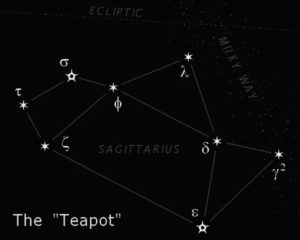The Sky in September 2017
by Dee Sharples –
September is upon us and brings with it less hours of daylight but also the opportunity to observe the night sky earlier in the evening. The autumn equinox occurs at 4:02 P.M. on September 22 and is the official start of fall in the Northern Hemisphere.
Soon the sky will have sufficiently darkened by 8:30 P.M. to easily spot the bright planet Jupiter low near the horizon in the west-southwest. Jupiter has been putting on a brilliant performance for several months but September will be the last opportunity to see it in the evening. Soon it will seem as though the giant planet is moving behind the sun from our vantage point here on Earth. In reality it’s the Earth orbiting around the sun much faster than Jupiter which changes our perspective of where it is in the sky. Earth revolves around the sun in one year while Jupiter takes 12 years to make that journey!
Saturn, the ringed planet, can be found almost due south after sunset, about 30 degrees (3 fist-widths) up from the horizon. It will look like a fairly bright yellowish “star”. To locate Saturn, face south, hold your arm outstretched in front of you parallel to the ground and make a fist. Your fist measures approximately 10 degrees against the backdrop of the sky. Roughly measure three fist-widths up from the horizon to a fairly bright yellowish “star” which is Saturn.
Use your fist once again to locate the red supergiant star Antares a little more than one fist-width below and to the right of Saturn. Can you see the difference in color between orange Antares and yellowish Saturn?
 The beautiful constellation Sagittarius graces the sky in the south this month. Since its stars don’t shine quite as brightly as Saturn, you’ll have to wait until the sky is fully dark to view it. It will help to get away from any lights which will interfere with your eyes adjusting to the dark. Sagittarius can be found to the left of Saturn but a little closer to the horizon. Although Sagittarius is known in mythology as the archer, this constellation contains an asterism (group of stars) that makes it look very much like the outline of a teapot, with its handle on the left and its spout on the right.
The beautiful constellation Sagittarius graces the sky in the south this month. Since its stars don’t shine quite as brightly as Saturn, you’ll have to wait until the sky is fully dark to view it. It will help to get away from any lights which will interfere with your eyes adjusting to the dark. Sagittarius can be found to the left of Saturn but a little closer to the horizon. Although Sagittarius is known in mythology as the archer, this constellation contains an asterism (group of stars) that makes it look very much like the outline of a teapot, with its handle on the left and its spout on the right.
Once you find Sagittarius, look for the Milky Way, the galaxy in which we live. Scientists have estimated that the Milky Way is made up of between 100 billion and 400 billion stars. It’s the light from these stars which creates the milky glow you can see rising up like steam from the spout of the teapot, spreading overhead, and ending in the northeastern sky.
The Cassini spacecraft has been transmitting images and scientific data from Saturn since July 1, 2004, when it entered orbit around that planet. The spacecraft traveled 2.2 billion miles for almost seven years taking a roundabout route to gain gravity assists from Venus, Earth and Jupiter to reach its destination.
In January 2005, Cassini launched the Huygens space probe which it had carried to Saturn. The Huygens probe was built by the European Space Agency (ESA). The purpose of Huygens was to descend through the thick hazy atmosphere of Titan, Saturn’s largest moon, gather data and images, and land on its surface. The probe successfully landed on Titan and functioned for over an hour before its battery power was depleted. This was the first time a spacecraft has landed on the moon of another planet other than Earth.
Sadly this 13-year mission will come to an end on September 15. Cassini’s rocket fuel is almost depleted, and when that happens, control of the spacecraft will no longer be possible. To avoid any chance that microbes from Earth which may have survived on Cassini could contaminate one of Saturn’s moons if a collision occurred in the future, a fiery plunge through Saturn’s atmosphere will take place. However, before its demise, Cassini will perform a series of close passes of Saturn’s rings, as well as the planet itself and some of its small, inner moons, and provide tremendous scientific data.
For more information on Cassini and Huygens, check out the NASA website at
https://saturn.jpl.nasa.gov/
 Dee Sharples is an amateur astronomer who enjoys observing planets, star clusters and the Moon through her telescope. She is a member of ASRAS (Astronomy Section of the Rochester Academy of Science) and records “Dee’s Sky This Month”, describing what can be seen in the sky, on the ASRAS website at rochesterastronomy.org. Watch for her monthly Owl Light News feature to learn more about the night sky.
Dee Sharples is an amateur astronomer who enjoys observing planets, star clusters and the Moon through her telescope. She is a member of ASRAS (Astronomy Section of the Rochester Academy of Science) and records “Dee’s Sky This Month”, describing what can be seen in the sky, on the ASRAS website at rochesterastronomy.org. Watch for her monthly Owl Light News feature to learn more about the night sky.